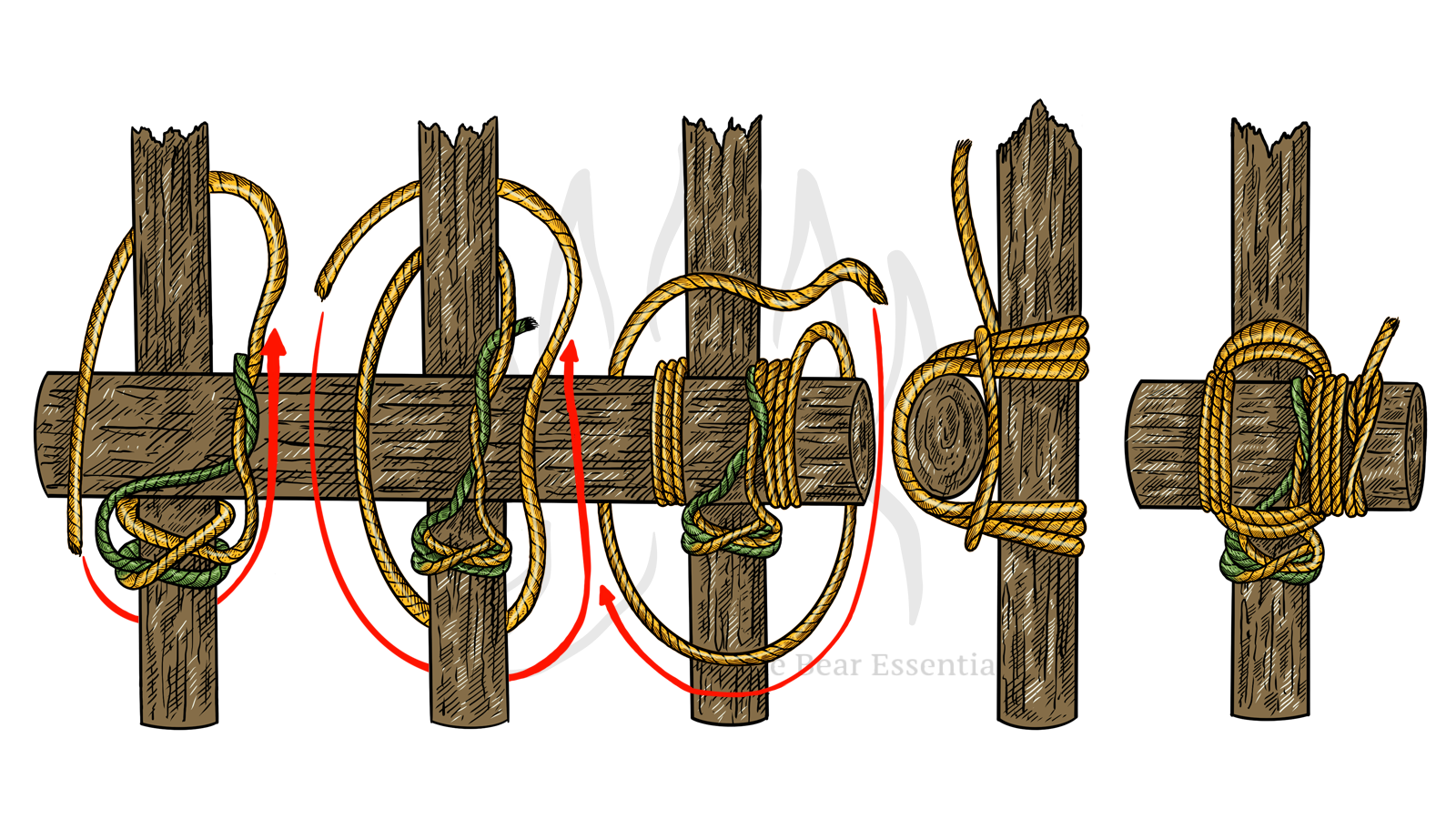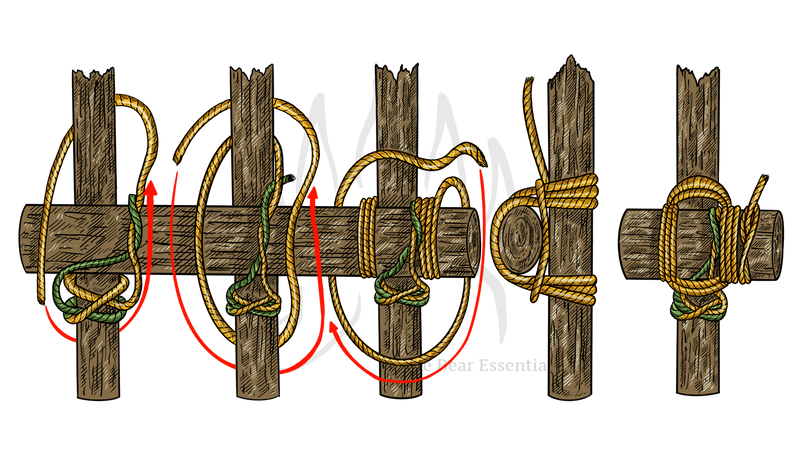How To Tie a Square Lashing
Usage
The Square Lashing is used to bind two sticks, logs, or poles together, at 90 degree angles. This lashing is load-bearing, making it ideal for constructing everything from chairs, cooking rigs, emergency stretchers, beds, and ladders to more advanced structures like bridges or scaffolding. Whether you're in a survival situation, building campsite furniture, or working on a bushcraft camp, the Square Lashing is a foundational knot to learn!
Why Learn the Knot
The Square Lashing is another essential / foundational knot I would highly recommend everyone knows. It opens the door to a wide range of outdoor projects. It’s not just about tying two poles together — it's about having the ability to build secure, functional structures to then expand on (think emergency shelters, cooking jigs, camp furniture, rafts etc)
It is one of the most essential knots for securing poles or structures, and is featured in the Bear Essentials Knot Tying Kit for its versatility and strength.
Common Uses
- Camping and Bushcraft
- Frame for a survival shelter
- Build camp furniture such as chairs, tables, or bed frames
- Create sturdy frames for shelters or rafts
- Use for securing poles in emergency stretchers
- Support gear like pots, tools, or even fishing setups
- Can be used as a campfire cooking rig
- Pioneering / Scout Projects
- Construct larger projects like scaffolding, fences, and bridges
- Lash poles together for tower or platform builds
- Create frames for rafts or raised camp beds
ABOK Number
(Ashley Book of Knots)
Other Names
TypeLashings
|
Notable Features
- Excellent for load-bearing tasks.
- Adaptable for different angles, from 45 degrees up to 90 degrees.
- Secure when tied properly and ideal for building large or small structures.
Similar / Related Knots
- Clove Hitch
- Advantage: Simple and fast to tie. It’s generally your starting and finishing knot.
- Disadvantage: May slip if not properly secured. (Can use the constrictor instead)
- Constrictor Knot
- Advantage: Provides extra security for permanent lashings / an upgrade to the Clove
- Disadvantage: Difficult to untie without cutting.
- Shear Lashing
- Advantage: Ideal for parallel poles or spars.
- Disadvantage: Not suitable for crossing poles in load-bearing situations.
- Japanese Square Lashing
- Advantage: Adds additional security and aesthetics to the lashing.
- Disadvantage: More time-consuming to tie.
- Transom Knot
- Advantage: Excellent for horizontal alignment of poles in projects like rafts or stretchers.
- Disadvantage: May not be suitable for projects requiring a 90-degree crossing.
- Tripod Lashing
- Advantage: Ideal for lashing 3 poles together
- Disadvantage: Not suitable for crossing poles at a 90 degree / different application
Security Level
Square Lashing is highly secure for load-bearing structures when properly tied. The key is in the tightness of the frapping turns, which must be pulled tight to ensure stability.
Downsides
The only downside of the Square Lashing is that, if not tied tightly enough, the structure may slip or come loose under heavy loads. Proper technique and tight frapping turns are essential. Other than that it technically can take a fair bit of rope to tie - but it’s necessary for a secure hold.
Structure
- Step 1: Begin with a Clove Hitch around the vertical pole, making sure it's tight.
- Step 2: Twist the short end of the rope around the long end from the Clove Hitch to secure it.
- Step 3: Wrap the rope over the front of the horizontal pole, around the back of the vertical pole, and over the front of the horizontal pole again.
- Step 4: Continue wrapping the rope for three turns, alternating between the front and back of each pole.
- Step 5: Make two or more frapping turns around the ropes between the poles, pulling tight.
- Step 6: Finish with two or more half hitches next to the original wraps to secure the lashing.
History
The Square Lashing has long been a staple in scouting and pioneering projects, used for its strength and reliability in building stable structures. Its use in constructing frames, scaffolds, and bridges dates back to early outdoor manuals, making it a go-to knot for any large-scale outdoor build.
FAQ
What is the Square Lashing used for?
It’s used to bind two poles together at right angles, providing a stable, load-bearing connection for building projects like bridges, scaffolding, or camp furniture.
How do I secure the frapping turns?
Pull the frapping turns as tight as possible, using leg strength if needed, to ensure the lashing holds securely.
Can Square Lashing handle heavy loads?
Yes, when tied properly, it can support moderate to heavy loads, but the key is in the tightness of the wraps and frapping turns.
What materials do I need for Square Lashing?
Two poles and rope, the amount depending on the thickness of the poles. Bushcraft Paracord or a similar strong, non-stretch rope is ideal.
Can this knot be used for angles less than 90 degrees?
Yes, Square Lashing works well for angles as small as 45 degrees, making it adaptable for various projects.
Important Notes on Safety
Ensure that all frapping turns are pulled tight and that the Clove Hitch is properly secured to prevent slipping. If the lashing is not tight enough, it can cause the structure to collapse under load. Always check the stability of the lashing before using it for load-bearing tasks.









